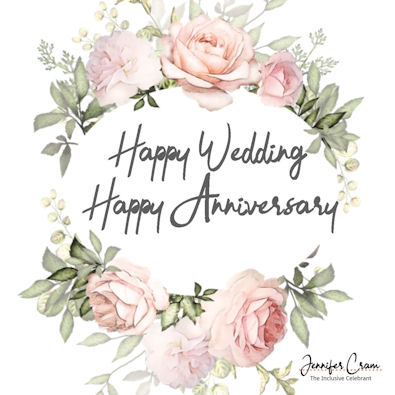You Absolutely Should Plan
Your Wedding with Anniversaries in Mind
Categories: | Vow Renewals | Wedding Ceremony |
 Are you planning your wedding
ceremony with future celebrations of wedding
anniversaries in mind? You should. Weddings are
about making memories, and one of the ways to keep
the memory of your wedding alive is to celebrate
your wedding anniversaries.
Are you planning your wedding
ceremony with future celebrations of wedding
anniversaries in mind? You should. Weddings are
about making memories, and one of the ways to keep
the memory of your wedding alive is to celebrate
your wedding anniversaries.One of the issues I frequently come across when planning renewal of vows ceremonies is an absence of information about the wedding, particularly about the marriage ceremony. Regardless of whether you celebrate your anniversary with a romantic private dinner, a big party, or a formal renewal of vows and celebration, a little forward planning can make a huge difference. It all comes down to the relative importance to you of being able to replicate aspects of your wedding day, revisit places, and celebrate.
I feel that planning your wedding with future wedding anniversaries in mind is particularly important at the moment, when COVID-19 has imposed so many restrictions on weddings. And I'm not just talking about the big milestone anniversaries that tend to be marked by parties, renewal of vows, and other celebrations, but every anniversary..
Are you on the same page?
Celebrating "ordinary"
anniversaries
Your venue
Your vows
is
Regardless of the size, complexity, or formality of
your wedding ceremony, your vows will be the core of
it. As they will in any Renewal of Vows in the
future. A few simple steps will ensure that you have
a copy of them available- Finalise your vows early
I'm a fan of shared vows, where both of you make the same personal promises to one another, having discussed and negotiated the content of those promises. Because that process takes time, it also tends to ensure that your vows are finalised early and I can then include them in the script of your ceremony and created a bound copy as a keepsake. - Create and save a printed copy of your vows
Regardless of whether you choose to write you vows on a device and/or read your vows from your phone, you keep a printed copy for future reference. Technology changes, and neither the device nor the software to read your vows may be available in the future.
Your music
Ritual and symbolic
objects
In contemporary weddings it is very common to include a symbolic ritual. When choosing a ritual, give some thought to what objects you will need to use, and how, if at all, you can keep and utilise them during future celebrations. Some items lend themselves to being framed or hung on the wall as decoration. Others to display and future use.
Your presentation
(ceremonial) certificate
Your photos
Photos can also be part of an ongoing record, a series. We routinely take photos of our kids on the first day of school every year, often in the same place so that there is a point of reference and on their birthdays, sitting in a chair ready to blow out the candles on their cake. These photos serve not just as a record of a milestone and a celebration but also as part of the series that records their growth and development. Growth and change throughout a marriage can be documented in similar ways. For example, if you plant a tree as part of your wedding, take a photograph of the the two of you standing next to the tree on every anniversary. Replicating wedding photos taken with your parents, members of your bridal party, can also create a great series. In the absence of those people, photos of you with their photo, or holding the original wedding photo, mark the passage of time. Something as simple as hauling out your marriage certificate and replicating the close up of your two hands on the certificate can create an extremely evocative series. Copy baby milestone photo sessions practice by adding a printed card to date the photo, eg 1st anniversary, or the date.
Order of Service or
Ceremony Program
is
While not many couples actually produce an Order of
Service for their guests, and who would if you're
only having a handful of people, a good way to make
sure you document those aspects of your ceremony and
celebration is to create a detailed Memories of
Our Day document as a historical record.- Order of Service
An Order of Service usually includes
- Names of the couple, Date, Time, and Place of the wedding ceremony
- Names of the parents
- Names of the bridal party and their roles (for example, in a traditional wedding the bridal party would include some or all of the following: Best Man, Chief Bridesmaid, Groomsman, Bridesmaid, Flower Girl, Ring Bearer, Page Boy)
- Names of your witnesses
- Name of your celebrant
- Name of any live musician or musical group
- An outline of the ceremony, with music choices - listed under the relevant element of the service, eg, Processional, Signing, Recessional
- The full text of any readings plus who delivered it
- The full text of your vows
- A list of all guests, with notes as to who they are (eg, grandmother, work colleague etc
- A list of everyone who played a role in your ceremony, eg, participants in a ritual
- Description of symbolic objects used in the ceremony
- Description of your rings, where you got them from, any engravings. Add the price. It will be of great interest in 50 years time!
- Details of what each of you, the bridal party, and close family members wore
- The flowers, including any reason for choice of particular flowers
- Transport - make, model, colour of the vehicles used, plus any other pertinent details. In a 65th wedding anniversary ceremony I shared the story of how the bride's father and brother worked right up to the wedding on the groom's little racing green MG so the couple could take off on their road-trip honeymoon because it said so much about how the family embraced the marriage.
- Menu for reception, including the flavour of your cake and who made it
- Music played at your reception
- A list of everyone who made speeches (if you can get a copy of those speeches, include them as well)
- Anything that did not go according to plan and how you dealt with it
- Anything that surprised you
- Funny and/or especially poignant memories
As with your vows, keep a print copy.
On the practical side
- Where possible, use acid-free paper to ensure your copies survive happily
- Store everything together
- Make sure your children and others know where everything is stored - it will make it much easier for them to organise a fantastic surprise celebration of a milestone anniversary sometime in the future.
Thanks for reading!
se hostAperthayou 0 Things
